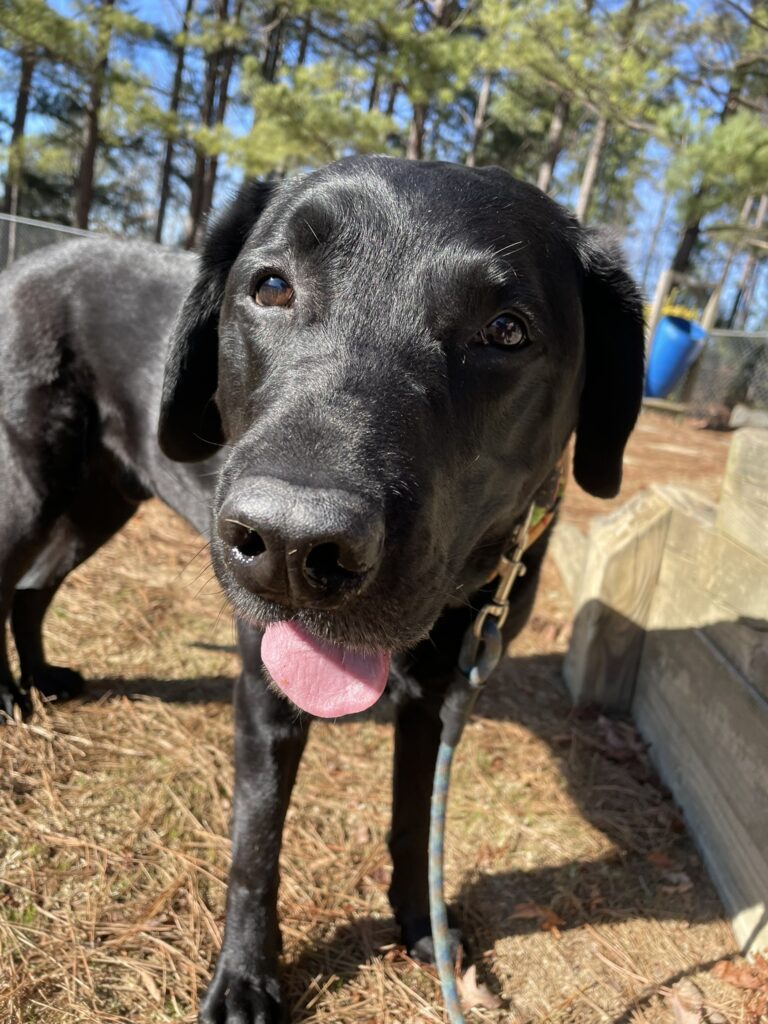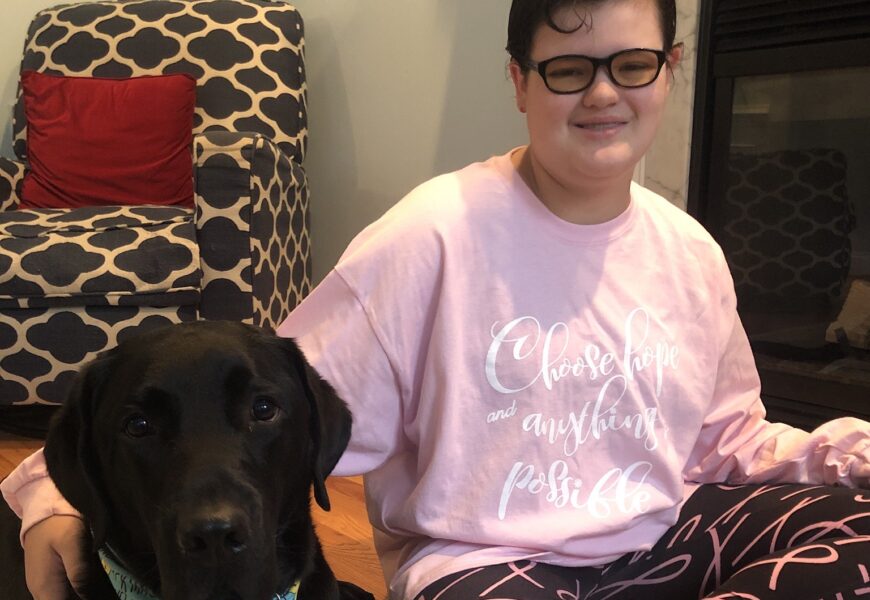Meet the Lab living his best life as a seizure-alert dog for an amazing young woman.
by Jen Reeder
A black Lab named Chick sleeps in a custom bed decorated with two of his favorite things – dinosaurs and bananas – in a college dorm room next to his favorite person: Chloe Veeder, a 19-year-old college student.
He’s earned this ideal living situation. They both have.
When Veeder was 11 years old, she suffered a traumatic brain injury (TBI) when she hit her head on the bottom of a swimming pool. The injury caused serious vision issues, and a year later, she started having seizures – one to three every day. Once, she experienced 16 back-to-back seizures in a single day.
“I had to be in a wheelchair because for most of my seizures, I go unconscious, so I would just fall wherever I was,” she recalls. “And my parents had to be wherever I was. So if I was showering, they had to be in the room with me so if I fell, they could turn the water off and get me out.”
Hitting her head again could cause further trauma and more health issues, so she required adult supervision at school as well. An aide needed to be with her constantly, so she lost most of her friends because “no 12-year-old wants to be hanging out with an adult 24/7.”
After meeting a service dog handler and her dog, the family applied for a seizure-alert dog from the nonprofit Eyes Ears Nose & Paws in Hillsborough, North Carolina. Veeder also applied for and received a scholarship from the nonprofit Canines for Disabled Kids to help pay for the dog; service dogs cost around $50,000, and families typically must cover half that amount.
In 2018 – soon after Veeder’s 13th birthday – she partnered with Chick. The family hoped Chick would be able to get help whenever she had a seizure so that she wouldn’t need constant supervision.
“We were hoping that there could be some pre-alerts [to seizures], but we weren’t certain that would happen,” she says. “But when we got Chick, he surpassed all of our expectations.”

It turns out that Chick always detects Veeder’s seizures 20-60 minutes before they happen, and then lies on top of her during seizures to offer deep pressure that shortens how long they last.
Heat and stress are the two main triggers that would lead to Veeder having a seizure, and prior to partnering with Chick, she felt stressed about being so isolated. But back at school, he proved to be a social bridge. Other high school students would approach her to ask about her service dog and became close friends she still has today.
“When I got Chick and doors started to open up again and I had a buddy by my side, it was a lot less stressful,” she says. “I think that was one of the main reasons that the seizures started to slow down.”
After partnering with Chick, Veeder averaged one seizure a day. After a year with Chick, she might have one or two per week. Toward the end of high school, she stopped having seizures and – knock on wood – hasn’t had one in over two years.
The Lab has been living his best life while helping Veeder embrace hers. His favorite pastime is napping – and snoring – until he spies a stick to carry or water to swim in. If someone opens a banana, he opens his “drool faucet” simply from smelling his favorite treat. When he finds a store’s dog toy aisle, Veeder lets him choose a toy – and he almost always picks a dinosaur and carries it straight to the checkout line, to the delight of other shoppers.
The Lab also likely saved Veeder’s life when she was 15. She hadn’t yet been diagnosed with a rare form of diabetes when her blood sugar got so high that her body went into diabetic ketoacidosis; her organ systems started to shut down, and to her parents, it looked like she was having another seizure.
“The weird thing was that Chick did not alert beforehand – he’s still 100 percent accurate. My mom kept trying to get him to do deep pressure therapy, and he was completely ignoring her,” she says. “She was really confused because normally he doesn’t even need any cue. He does it on his own.”
So her parents called 911, and she was rushed to the hospital, where the team saved her life. Now she uses an insulin pump.
“Chick knew that something was different and had he not been disobedient – if he had acted like everything was normal and done the normal seizure response – it wouldn’t have helped, my parents wouldn’t have called 911, and then I may or may not be talking to you today,” Veeder says.
Instead, Veeder graduated from high school with Chick by her side – dressed in a custom cap and gown made by a friend. And she’s pursuing her dream of becoming a nurse by studying at Queen’s University at Charlotte – more than two hours away from home.

“I can go to college two and a half hours away from my parents. Before Chick, they could not be two and a half minutes away,” she says. “I was just trying to get through the day to day.”
She loves college so far and so does eight-year-old Chick, who is the “star of the campus.”
This thrills Kristin Hartness, executive director of Canines for Disabled Kids, a national nonprofit that helps connect children up to 18 years old with service dogs, arranges scholarships, and offers educational programs for communities around the country.
Hartness got to know Veeder when she applied for the CDK scholarship, and later visited Veeder’s school to educate the faculty and administration about service dogs.
“One of the things that I really admire is Chloe’s determination to go forward – to not let this life-changing injury be something that was going to prevent her from interacting with life,” she says. “It’s a huge decision to add a service dog and to trust that your trainer is going to put the right dog in your hands…. This team makes it seem effortless.”
For more information about Canines for Disabled Kids, visit: caninesforkids.org. For more information about Eyes Ears Nose & Paws, visit: eenp.org.
Please Don’t Pet a Working Lab
Labs are one of the most popular breeds trained as service dogs, according to Kristin Hartness, executive director of Canines for Disabled Kids. They’re naturally good at retrieving, are patient with handlers, and are a solid size.
“Labs just bring so much to the table and they love their people, and that’s so critical to a successful service partnership,” Hartness says.
It can be hard for Lab lovers to resist petting such amazing dogs – but we must. Working dogs need to focus on their job assisting their handler and shouldn’t be distracted.
Though many people are respectful, Chloe Veeder can be annoyed by “drive-by petting” when people reach out and pet her service dog as they pass, or ignore her requests to not pet her dog.
“Especially when I first got Chick, I was so young that maybe adults don’t like a 13-year-old telling them what to do, so some adults I think just felt entitled that ‘There was a cute dog, and I’m going to pet it,’” she recalls.
Please: Let’s stick to petting our own Labs!




